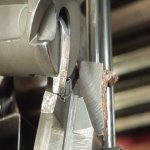I blew up my Norc M14 this past weekend. Last 5 rounds before I packed up... Boom. (Of course, last five rounds...)
I was tired and stupid after a day of shooting, and dropped the bolt on a chambered round without thinking. The round had chambered from the magazine, but the magazine wasn't seated properly - so I locked the bolt back, dropped the mag, and then dropped the bolt. Like I said, tired and stupid, and hadn't fired an M14 in a couple of years. (Note to self: Don't treat them like ARs...)
Having said that, the rifle helped. The firing pin went forward to set the round off. (There was a clear/clean impression in the primer - I recovered the base of the round.)
The bolt was also not locked when it went boom (so, either shallow head space or bad round), so the explosion was loud and in my face. Rifle flew forward about 20 feet, which is a blessing because the other way would have been painful.
They were reloads - I know that's the obvious suspect. I hand measure all my rifle powders for every round. I also use a case gauge and measure OAL. So - it is possible that I missed a round, but I'm definitely not sloppy with my reloads. (I reload for everything up to 50BMG, so I am very anal.)
I had a bunch of metal/brass/dirt blown into my hands, so I have a few hundred new freckles. The bolt slammed into my right hand when it came back - that clipped a finger. No break but very sore.
All things considered - I was fantastically lucky. More importantly, no one around me was hurt.
Not sure if I can be of any help in your research, but let me know. One piece of advice - if you are trying to manually replicate what happened to me - lock the rifle down and be far away from it.
In the last decade or so, I've had a 22LR go off OOB in a semi pistol (gun's fault), a 223 go off (my fault - which is why I'm so anal about reloads now) and now a 308. You want no part of that in your face...










































































